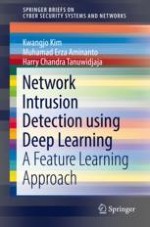2018 | OriginalPaper | Buchkapitel
6. Deep Feature Learning
verfasst von : Kwangjo Kim, Muhamad Erza Aminanto, Harry Chandra Tanuwidjaja
Erschienen in: Network Intrusion Detection using Deep Learning
Verlag: Springer Singapore
Aktivieren Sie unsere intelligente Suche, um passende Fachinhalte oder Patente zu finden.
Wählen Sie Textabschnitte aus um mit Künstlicher Intelligenz passenden Patente zu finden. powered by
Markieren Sie Textabschnitte, um KI-gestützt weitere passende Inhalte zu finden. powered by
